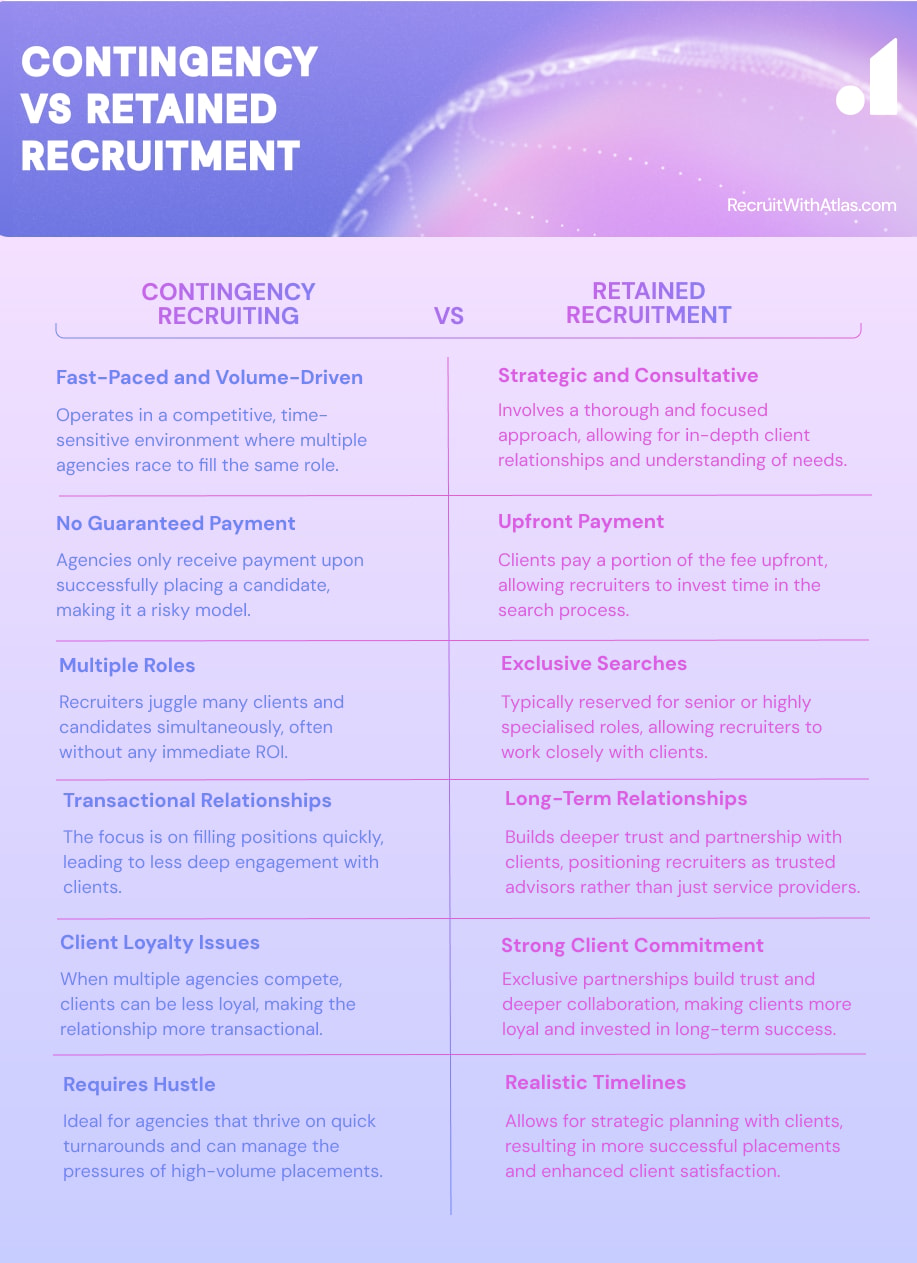
// Recruitment Technology, Executive Search Best Practices, Recruitment Strategies
Contingency vs Retained Recruitment. What Powers Your Agency - Volume, Value, or Both?
14/11/2024
10 MIN
When you’re leading an executive search agency, the recruitment model you choose can significantly impact your workflow, client relationships, and revenue. Understanding the differences between contingency and retained recruitment models is key to deciding which fits your agency’s needs.
For instance, if you’re focused on filling high-level executive roles, a retained model allows you to thoroughly find quality candidates without time pressure, while the contingency model is great for filling positions quickly, especially when you need to tap into a larger pool of candidates under tight deadlines.
Whichever model you go for, efficiency and time really matter. That’s why many agency leaders are now turning to AI tools like recruitment platforms to cut down on repetitive tasks and make it easier to source candidates and manage clients.
Let’s delve into both approaches and explore when each might be the best option for your agency.

What is Contingency Recruitment? Fast-Paced, Risky, and Volume-Driven
Imagine this, a client needs a new sales director, but they’ve engaged three different recruitment agencies to find the right candidate. You’re competing in a race against time, juggling multiple clients and candidates, hoping that your pick gets hired first.
This is the essence of contingency recruitment:
- This model often leads to a “numbers game” — high volumes of candidates and jobs, but less deep client engagement.
- Multiple recruitment agencies compete to fill the same role, creating a fast-paced, transactional environment.
- You often work on multiple roles for free. Earnings are based on the number of positions filled with no promise of a fee unless a placement is made.
- While potentially lucrative, it carries risks due to time and resources invested without assurance of return.
If your agency thrives on a quick turnaround and can handle the hustle of placing numerous candidates, contingency recruitment might be for you. But you’ll also need to prepare for the inevitable rollercoaster of income variability and the strain of managing multiple clients with little client loyalty.
How AI Accelerates Contingency Recruiting with Faster Access to Quality Candidates
Contingency recruitment is all about speed. Here’s where an AI-powered recruitment platform can transform your workflow. These tools can automatically source and organise candidates based on client needs, cutting down the time it takes to identify top candidates.
Imagine using AI candidate sourcing to sift through thousands of CVs, rank candidates by relevance, and even predict a candidate’s likelihood of accepting an offer. This allows you to move faster than competitors and increases your chances of closing deals while maintaining a high standard of quality.
Want to save hours and find the perfect candidates in seconds?
Use advanced filters to quickly narrow down searches making it easy to identify top executives who match your clients’ specific needs. It’s all about saving time and increasing your efficiency.
Upgrade your sourcing process now!
What is Retained Recruitment? Strategic, Consultative, and Secure
Now, consider a different scenario. You’ve been retained by a client to find a new Chief Technology Officer (CTO) for their fast-growing startup. You’ve received a portion of your fee upfront, which means you can dedicate time and resources to conducting a thorough, high-quality search without the rush. You work closely with the client, holding weekly strategy meetings, and you’re able to set realistic timelines.
At its core, retained recruitment is about:
- A model where clients pay for an exclusive search, typically for senior or highly specialized roles.
- Focusing on a handful of high-quality placements and not scrambling for multiple jobs at once.
- Working more closely with clients, fostering deeper, long-term relationships.
- Positioning your agency as a trusted advisor, not just another business competing for attention.
- Securing your workload, allowing for focused and thorough searches without the rush to outpace competitors.
The benefits of retained recruitment go beyond just financial stability. As many experienced agency leaders have noted, retained recruitment offers a work-life balance many crave. You’re also likely to see a shift in candidate quality – executive-level candidates expect this level of professionalism, and the entire process becomes more streamlined and sophisticated.
The AI Advantage in Retained Recruitment
In retained recruitment, precision is key. An AI-powered recruitment platform can elevate your search by helping you build highly specialised talent pools, assess skills more accurately, and even forecast candidate availability. By using AI, you can improve candidate matching and predict the likelihood of long-term success in the role.
Additionally, AI tools allow for more personalised candidate engagement, helping to nurture relationships with high-calibre candidates throughout the often lengthy executive search process.
As the recruitment process begins, using data-driven insights and automated communication allows you to keep candidates informed and engaged at every stage. This creates a better candidate experience, making them feel valued and connected. By sustaining their interest in the position, you’ll ultimately achieve better outcomes for both candidates and clients.
This consultative, strategic approach is crucial in retained recruitment, where the stakes – and the fees – are much higher.
Looking to stay connected without sacrificing quality? Our recruitment platform can help!
- Effortlessly create initial drafts from job details
- Use your team’s knowledge for in-depth candidate insights
- Run multi-step campaigns across various communication channels
- Use a Chrome extension to add candidates to messaging sequences and edit messages in real time.
- Automate follow-ups with tailored emails that resonate with each candidate.
See how you can cut hours of work down to minutes!
What You Need to Know About Contingency and Retained Recruitment
Curious about the differences between recruitment models? Here are some common questions to help you decide which approach is best for your agency.
1. What’s the difference between contingency and retained recruitment?
Contingency recruitment means you only pay if the contingency recruiter finds the right candidate. It’s often a race, with multiple contingency recruiters competing to fill the same role, and you only get billed if one of them succeeds. Retained recruitment, though, is more structured. You pay upfront or in stages, and the recruiter is exclusively working on your search, so you get a more thorough, consultative service.
2. When is contingency recruitment a better option?
Contingency recruiting works well when you need to fill lower to mid-level roles fast and there are plenty of candidates to choose from. It’s ideal if you’re open to multiple agencies working on the same search, but it might not be the best choice for highly specialised or senior positions.
3. What are the benefits of retained recruitment for my agency?
With retained recruitment, you get a dedicated recruiter, higher-quality candidates, and a closer relationship with your recruiter. Because you’re paying upfront, the recruiter can invest more time and resources into the search, which leads to better results and less stress over timelines. Plus, it gives you financial certainty since the payment isn’t tied to a placement being made.
4. Can AI recruitment tools help with contingency or retained searches?
Absolutely. For contingency, AI can quickly sift through candidates, helping you act faster than other agencies. For retained searches, AI can dig deeper, matching candidates more precisely, and manage long-term pipelines – great for those hard-to-fill senior roles.
5. Which model leads to better client relationships?
Retained recruitment usually leads to stronger client relationships because the recruiter is more involved and invested in the process. It’s less transactional, so you get a more personalised, consultative service.
Contingency vs. Retained Recruitment – When to Use Each
Both models can coexist within your agency, depending on the client, the role, and your business strategy.
When to Use the Contingency Model
- Fast-fill roles – Contingency works well for roles that need to be filled quickly or for lower-level positions where time is of the essence.
- Volume recruitment – If you’re working on high-volume recruitment for multiple similar roles, contingency may be the better model, especially if you’re confident in finding candidates fast.
- Client hesitation – For clients reluctant to commit financially upfront, contingency offers a low-risk option to prove your worth before discussing long-term engagements.
When to Use the Retained Model
- High-value, senior roles – Retained recruitment is ideal for executive search or specialised positions where the stakes are high, and the process requires meticulous attention.
- Client engagement – If your client is looking for a more collaborative relationship, where your expertise is valued, retained search allows you to work closely with them and deliver a tailored solution.
- Financial predictability – If you’re looking to reduce financial risk and create a more predictable income stream, moving to retained search can offer stability and improve your agency’s long-term viability.
Tune in to this webinar by Louise Archer, the Founder of Retrained Search, as she dives into the essentials of retained search. Is it just for senior roles or only for search firms?
Learn how it differs from contingent recruitment and get tips on starting your own retained search practice and pitching it to clients. Also gain insight into how to tap into that hidden 70% of the talent pool and why commitment and partnership are so important in retained search.
Blending Both Models
Many successful agencies adopt a hybrid approach, using both contingency and retained models depending on the role and client. For example, you might use contingency for mid-level management roles but offer retained search for senior executive positions. This flexibility allows you to cater to a broader range of clients while maximising revenue potential.
Key Questions You Should Ask Before Selecting a Model
The question now becomes, which model is right for your agency? To answer that, you need to assess both your business goals and where you are in your agency’s lifecycle.
Are you focused on volume or quality?
If your agency is looking to place a high number of candidates and thrives on fast-moving roles, contingency might be the model that keeps the wheels turning. However, if you’re aiming for fewer, higher-value placements, retained recruitment offers more stability and quality control.
In either scenario, an AI recruitment platform can enhance your offering. For high-volume contingency recruitment, AI can automate repetitive tasks like sorting CVs, taking interview notes, and scheduling meetings, freeing you up to focus on client management and relationship building.
For retained recruitment, AI can offer valuable insights into candidate behaviours, market trends, and optimise the overall search process.
Do you have the client relationships to support retained recruitment?
Retained recruitment requires a certain level of trust and partnership with your clients. If you’re already well-established with a handful of loyal clients, transitioning them to a retained model could be easier than you think.
It’s all about demonstrating how this approach benefits them, whether it’s access to a more exclusive talent pool, a more structured hiring process, or simply the assurance that they’re your priority.
For contingency recruitment, AI-driven CRM tools can help you manage client relationships more effectively, keeping you front-of-mind and ensuring that your candidates stand out from the competition. In retained recruitment, AI can help track long-term client interactions, providing insights into client preferences and improving relationship management through data-driven strategies.
Are you ready to move to a consultative role?
The retained model is less about filling roles and more about offering a consultative service.
If you enjoy guiding clients through their hiring strategy, solving problems at a deeper level, and having a say in the talent management strategy, retained recruitment will allow you to do that. Your role becomes more sophisticated and advisory, and your clients will value you for it.
Do you want to diversify your offering?
A significant step to shifting towards retained recruitment is commoditizing parts of your service that clients are already benefiting from.
Things like employer branding advice, job profiling, or talent pooling are areas where you likely add value already, but don’t get paid for. Packaging these services into your retained offering can not only enhance your client relationships but also increase your revenue streams.
How to Make the Shift from Contingency to Retained Recruitment
If you’ve been operating on a contingency basis for years, transitioning to a retained model might seem daunting. After all, asking clients for a retainer requires confidence in your value and a shift in your approach. But the rewards, both financial and relational, can far outweigh the risks.
- Commoditise your services – Look at the services you’re already offering for free, from employer branding, candidate screening, to talent pooling. Package these as value adds. Clients are often willing to pay for these services but may not even realise they’re receiving them.
- Build client confidence – Simply asking for a retainer can signal to your clients that you’re serious about delivering results. Even if they decline initially, it opens the door for future conversations and can improve your negotiation position.
- Communicate the benefits – Ensure you have a clear understanding of how the retained model benefits your client as well as your agency. When clients realise they’ll receive a more thorough, personalised service, they’re often more willing to invest.
- Balance your offerings – You don’t have to drop contingency recruitment entirely. Use it as a backup for clients who are still hesitant or for roles that suit fast, high-volume recruitment. Over time, though, focusing more on retained work can help you grow your business sustainably.
Tune in as Russell Liebowitz, founder of Recruitemy, discusses his transition from contingency staffing to retained search and how this change positively impacted his recruitment approach, way of living, and overall satisfaction.
The Bottom Line – Which Model is Right for You?
Transitioning from contingency to retained recruitment may seem daunting, but it’s a natural progression for many agencies seeking a more balanced, higher-calibre approach to recruitment. It will require a shift in mindset, behaviour, and strategy, but the payoff can be significant.
For those looking to make the move, it’s essential to understand that it’s not an all-or-nothing decision.
Many agencies blend both models, starting with contingency to build up revenue and relationships, and then transitioning key clients to retained search for more specialised roles. In fact, this hybrid approach often helps smooth the transition and lets you enjoy the best of both worlds.
If you’ve been considering making the leap, now might be the perfect time to reflect on the long-term vision for your agency. Retained recruitment can offer higher fees, deeper relationships, and more stability – but only if you’re ready to embrace a consultative, strategic role with your clients.
Ultimately, the best recruitment model for your agency depends on your long-term vision. If you’re looking for predictability, stronger client relationships, and less pressure, retained search could be your next step. If your agency thrives on speed, volume, and high-stakes competition, contingency might remain a core part of your strategy.
By understanding the nuances of both models and how they align with your business goals, you can navigate the recruitment landscape more effectively. To enhance your capabilities, integrating AI tools, such as a recruitment platform, can streamline your efforts by automating mundane tasks, improving candidate sourcing, and optimising client management.
Whether you’re just starting out or looking to evolve your agency, knowing how to use AI can provide you with the competitive advantage needed to thrive in either – or both – of these recruitment models. See what Atlas can do for you!







